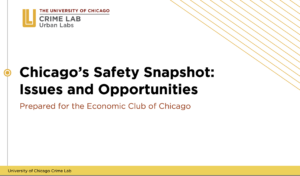Jan 2021
Reducing Crime Through Environmental Design: Evidence from a Randomized Experiment of Street Lighting in New York City
Topics
Methodologies
This paper offers novel experimental evidence that violent crimes can be successfully reduced by changing the situational environment that potential victims and offenders face. We focus on a ubiquitous but understudied feature of the urban landscape—street lighting—and report the first experimental evidence on the effect of street lighting on crime.
Topics
Methodologies

Economic Club of Chicago- Chicago’s Safety Snapshot: Issues and Opportunities
These slides were presented by the Crime Lab at a forum hosted by the Economic Club and Commercial Club of Chicago.

Violence Reduction Dashboard

Webinar: Overview of the City of Chicago’s Violence Reduction Dashboard
Launched in May 2021 by the City of Chicago, with design and technical support from the Crime Lab, the Dashboard is a first-of-its-kind comprehensive tool that allows unfettered public access to city violence trends categorizable by victim type, date, and geographic area.

Machine Learning Can Predict Shooting Victimization Well Enough To Help Prevent It
This National Bureau of Economic Research Working Paper shows that shootings are predictable enough to be preventable.
Latest Updates
Why America fell for guns
Megan Kang, a Crime Lab affiliate and Ph.D. candidate in sociology at Princeton University, writes an essay that describes America’s extraordinary levels of gun ownership in the context of a key turning point in US gun culture in the mid-20th century.

Oeindrila Dube on Cognitive Behavioral Training for Police
In this episode of Probable Causation, Dr. Oeindrila Dube discusses her research on Situational Decision-Making, a cognitive behavioral training program for police.

Incrementalism Beats YOLO
For Vital City’s “Does Evidence Matter?” issue, Crime Lab affiliate Philip Cook and Pritzker director Jens Ludwig provide commentary highlighting evidence that incremental social policies have a positive impact on society.

